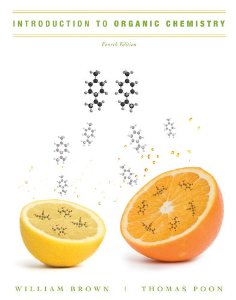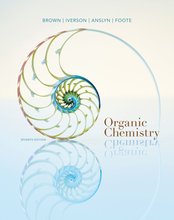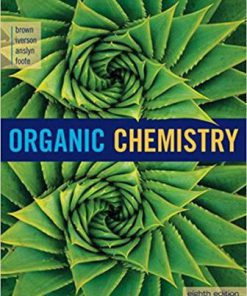Test Bank for Introduction to Organic Chemistry, 4th Edition: Brown
$35.00 Original price was: $35.00.$26.50Current price is: $26.50.
Test Bank for Introduction to Organic Chemistry, 4th Edition: Brown
Instant download Test Bank for Introduction to Organic Chemistry, 4th Edition: Brown pdf docx epub after payment.

Product details:
- ISBN-10 : 0470129239
- ISBN-13 : 978-0470129234
- Author: William H. Brown (Author), Thomas Poon (Author)
This text provides an introduction to organic chemistry for students who require the fundamentals of organic chemistry as a requirement for their major. It is most suited for a one semester organic chemistry course. In an attempt to highlight the relevance of the material to students, the authors place a strong emphasis on showing the interrelationship between organic chemistry and other areas of science, particularly the biological and health sciences. The text illustrates the use of organic chemistry as a tool in these sciences; it also stresses the organic compounds, both natural and synthetic, that surround us in everyday life: in pharmaceuticals, plastics, fibers, agrochemicals, surface coatings, toiletry preparations and cosmetics, food additives, adhesives, and elastomers.
Table of contents:
1 Covalent Bonding and Shapes of Molecules 1
1.1 How Do We Describe the Electronic Structure of Atoms? 2
1.2 What Is the Lewis Model of Bonding? 5
1.3 How Do We Predict Bond Angles and the Shapes of Molecules? 13
1.4 How Do We Predict If a Molecule Is Polar or Nonpolar? 17
1.5 What Is Resonance? 18
1.6 What Is the Orbital Overlap Model of Covalent Bonding? 21
1.7 What Are Functional Groups? 26
Summary of Key Questions 31
Quick Quiz 32
Problems 34
Real World Problems 37
Looking Ahead 38
Group Learning Activities 39
Chemical Connections
1A Buckyball: A New Form of Carbon 16
2 Acids and Bases 40
2.1 What Are Arrhenius Acids and Bases? 41
2.2 What Are Bronsted–Lowry Acids and Bases? 42
2.3 How Do We Measure the Strength of an Acid or Base? 44
2.4 How Do We Determine the Position of Equilibrium in an Acid–Base Reaction? 46
2.5 What Are the Relationships between Acidity and Molecular Structure? 48
2.6 What Are Lewis Acids and Bases? 52
Summary of Key Questions 55
Quick Quiz 56
Key Reactions 57
Problems 57
Real World Problems 59
Looking Ahead 59
Group Learning Activities 60
3 Alkanes and Cycloalkanes 61
3.1 What Are Alkanes? 62
3.2 What Is Constitutional Isomerism in Alkanes? 64
3.3 How Do We Name Alkanes? 66
3.4 What Are Cycloalkanes? 71
3.5 How Is the IUPAC System of Nomenclature Applied to Molecules that Contain Functional Groups? 72
3.6 What Are the Conformations of Alkanes and Cycloalkanes? 73
3.7 What Is Cis–Trans Isomerism in Cycloalkanes? 80
3.8 What Are the Physical Properties of Alkanes and Cycloalkanes? 84
3.9 What Are the Characteristic Reactions of Alkanes? 87
3.10 What Are the Sources of Alkanes? 88
Summary of Key Questions 91
Quick Quiz 92
Key Reactions 93
Problems 93
Real World Problems 97
Looking Ahead 98
Group Learning Activities 99
Putting it Together 99
Chemical Connections
3A The Poisonous Puffer Fish 81
3B Octane Rating: What Those Numbers at the Pump Mean 90
4 Alkenes and Alkynes 103
4.1 What Are the Structures and Shapes of Alkenes and Alkynes? 105
4.2 How Do We Name Alkenes and Alkynes? 107
4.3 What Are the Physical Properties of Alkenes and Alkynes? 115
4.4 Why Are 1-Alkynes (Terminal Alkynes) Weak Acids? 116
Summary of Key Questions 117
Quick Quiz 118
Problems 118
Real World Problems 121
Looking Ahead 122
Group Learning Activities 122
Chemical Connections
4A Ethylene, a Plant Growth Regulator 104
4B Cis–Trans Isomerism in Vision 106
4C Why Plants Emit Isoprene 115
5 Reactions of Alkenes and Alkynes 123
5.1 What Are the Characteristic Reactions of Alkenes? 123
5.2 What Is a Reaction Mechanism? 124
5.3 What Are the Mechanisms of Electrophilic Additions to Alkenes? 130
5.4 What Are Carbocation Rearrangements? 140
5.5 What Is Hydroboration–Oxidation of an Alkene? 143
5.6 How Can an Alkene Be Reduced to an Alkane? 145
5.7 How Can an Acetylide Anion Be Used to Create a New Carbon–Carbon Bond? 148
5.8 How Can Alkynes Be Reduced to Alkenes and Alkanes? 150
Summary of Key Questions 151
Quick Quiz 152
Key Reactions 153
Problems 154
Chemical Transformation 157
Real World Problems 158
Looking Ahead 158
Group Learning Activities 159
Chemical Connections
5A Catalytic Cracking and the Importance of Alkenes 127
6 Chirality: The Handedness of Molecules 160
6.1 What Are Stereoisomers? 161
6.2 What Are Enantiomers? 161
6.3 How Do We Designate the Configuration of a Stereocenter? 166
6.4 What Is the 2n Rule? 168
6.5 How Do We Describe the Chirality of Cyclic Molecules with Two Stereocenters? 172
6.6 How Do We Describe the Chirality of Molecules with Three or More Stereocenters? 174
6.7 What Are the Properties of Stereoisomers? 174
6.8 How Is Chirality Detected in the Laboratory? 175
6.9 What Is the Significance of Chirality in the Biological World? 176
6.10 How Can Enantiomers Be Resolved? 177
Summary of Key Questions 179
Quick Quiz 180
Problems 181
Chemical Transformations 184
Real World Problems 185
Looking Ahead 186
Group Learning Activities 187
Putting it Together 187
Chemical Connections
6A Chiral Drugs 178
7 Haloalkanes 190
7.1 How Are Haloalkanes Named? 191
7.2 What Are the Characteristic Reactions of Haloalkanes? 193
7.3 What Are the Products of Nucleophilic Aliphatic Substitution Reactions? 195
7.4 What Are the SN2 and SN1 Mechanisms for Nucleophilic Substitution? 197
7.5 What Determines Whether SN1 or SN2 Predominates? 201
7.6 How Can SN1 and SN2 Be Predicted Based on Experimental Conditions? 206
7.7 What Are the Products of β?Elimination? 208
7.8 What Are the E1 and E2 Mechanisms for β?Elimination? 211
7.9 When Do Nucleophilic Substitution and β?Elimination Compete? 214
Summary of Key Questions 217
Quick Quiz 218
Key Reactions 218
Problems 219
Chemical Transformations 223
Looking Ahead 224
Group Learning Activities 225
Chemical Connections
7A The Environmental Impact of Chlorofluorocarbons 193
7B The Effect of Chlorofluorocarbon Legislation on Asthma Sufferers 216
8 Alcohols, Ethers, and Thiols 226
8.1 What Are Alcohols? 227
8.2 What Are the Characteristic Reactions of Alcohols? 232
8.3 What Are Ethers? 245
8.4 What Are Epoxides? 249
8.5 What Are Thiols? 253
8.6 What Are the Characteristic Reactions of Thiols? 256
Summary of Key Questions 257
Quick Quiz 258
Key Reactions 259
Problems 260
Chemical Transformations 263
Real World Problems 264
Looking Ahead 264
Group Learning Activities 265
Chemical Connections
8A Nitroglycerin: An Explosive and a Drug 230
8B Blood Alcohol Screening 245
8C Ethylene Oxide: A Chemical Sterilant 253
9 Benzene and Its Derivatives 266
9.1 What Is the Structure of Benzene? 267
9.2 What Is Aromaticity? 270
9.3 How Are Benzene Compounds Named, and What Are Their Physical Properties? 273
9.4 What Is a Benzylic Position, and How Does It Contribute to Benzene Reactivity? 276
9.5 What Is Electrophilic Aromatic Substitution? 278
9.6 What Is the Mechanism of Electrophilic Aromatic Substitution? 279
9.7 How Do Existing Substituents on Benzene Affect Electrophilic Aromatic Substitution? 288
9.8 What Are Phenols? 296
Summary of Key Questions 303
Quick Quiz 304
Key Reactions 304
Problems 305
Chemical Transformations 309
Real World Problems 310
Looking Ahead 311
Group Learning Activities 312
Chemical Connections
9A Carcinogenic Polynuclear Aromatics and Cancer 277
9B Capsaicin, for Those Who Like It Hot 300
10 Amines 313
10.1 What Are Amines? 313
10.2 How Are Amines Named? 316
10.3 What Are the Characteristic Physical Properties of Amines? 319
10.4 What Are the Acid–Base Properties of Amines? 321
10.5 What Are the Reactions of Amines with Acids? 325
10.6 How Are Arylamines Synthesized? 327
10.7 How Do Amines Act as Nucleophiles? 328
Summary of Key Questions 330
Quick Quiz 331
Key Reactions 331
Problems 332
Chemical Transformations 334
Real World Problems 335
Looking Ahead 337
Group Learning Activities 337
Putting it Together 338
Chemical Connections
10A Morphine as a Clue in the Design and Discovery of Drugs 314
10B The Poison Dart Frogs of South America: Lethal Amines 319
11 Spectroscopy 341
11.1 What Is Electromagnetic Radiation? 342
11.2 What Is Molecular Spectroscopy? 344
11.3 What Is Infrared Spectroscopy? 344
11.4 How Do We Interpret Infrared Spectra? 347
11.5 What Is Nuclear Magnetic Resonance? 358
11.6 What Is Shielding? 360
11.7 What Is a 1H-NMR Spectrum? 360
11.8 How Many Resonance Signals Will a Compound Yield in Its 1H?NMR Spectrum? 362
11.9 What Is Signal Integration? 365
11.10 What Is Chemical Shift? 366
11.11 What Is Signal Splitting? 368
11.12 What Is 13C?NMR Spectroscopy, and How Does It Differ from 1H?NMR Spectroscopy? 371
11.13 How Do We Solve an NMR Problem? 374
Summary of Key Questions 378
Quick Quiz 380
Problems 381
Real World Problems 393
Looking Ahead 394
Group Learning Activities 395
Chemical Connections
11A Infrared Spectroscopy: A Window on Brain Activity 348
11B Infrared Spectroscopy: A Window on Climate Change 354
11C Magnetic Resonance Imaging (MRI) 371
12 Aldehydes and Ketones 396
12.1 What Are Aldehydes and Ketones? 397
12.2 How Are Aldehydes and Ketones Named? 397
12.3 What Are the Physical Properties of Aldehydes and Ketones? 401
12.4 What Is the Most Common Reaction Theme of Aldehydes and Ketones? 402
12.5 What Are Grignard Reagents, and How Do They React with Aldehydes and Ketones? 402
12.6 What Are Hemiacetals and Acetals? 407
12.7 How Do Aldehydes and Ketones React with Ammonia and Amines? 413
12.8 What Is Keto?Enol Tautomerism? 417
12.9 How Are Aldehydes and Ketones Oxidized? 420
12.10 How Are Aldehydes and Ketones Reduced? 423
Summary of Key Questions 425
Quick Quiz 426
Key Reactions 427
Problems 428
Chemical Transformations 431
Spectroscopy 432
Real World Problems 433
Looking Ahead 435
Group Learning Activities 436
Chemical Connections
12A A Green Synthesis of Adipic Acid 422
13 Carboxylic Acids 437
13.1 What Are Carboxylic Acids? 437
13.2 How Are Carboxylic Acids Named? 438
13.3 What Are the Physical Properties of Carboxylic Acids? 441
13.4 What Are the Acid–Base Properties of Carboxylic Acids? 442
13.5 How Are Carboxyl Groups Reduced? 446
13.6 What Is Fischer Esterification? 449
13.7 What Are Acid Chlorides? 453
13.8 What Is Decarboxylation? 455
Summary of Key Questions 459
Quick Quiz 459
Key Reactions 460
Problems 461
Chemical Transformations 464
Real World Problems 464
Looking Ahead 467
Group Learning Activities 467
Chemical Connections
13A From Willow Bark to Aspirin and Beyond 446
13B Esters as Flavoring Agents 451
13C Ketone Bodies and Diabetes 456
14 Functional Derivatives of Carboxylic Acids 468
14.1 What Are Some Derivatives of Carboxylic Acids, and How Are They Named? 469
14.2 What Are the Characteristic Reactions of Carboxylic Acid Derivatives? 474
14.3 What Is Hydrolysis? 475
14.4 How Do Carboxylic Acid Derivatives React with Alcohols? 480
14.5 How Do Carboxylic Acid Derivatives React with Ammonia and Amines? 483
14.6 How Can Functional Derivatives of Carboxylic Acids Be Interconverted? 485
14.7 How Do Esters React with Grignard Reagents? 486
14.8 How Are Derivatives of Carboxylic Acids Reduced? 488
Summary of Key Questions 492
Quick Quiz 493
Key Reactions 493
Problems 495
Chemical Transformations 498
Real World Problems 498
Looking Ahead 501
Group Learning Activities 501
Putting it Together 501
Chemical Connections
14A Ultraviolet Sunscreens and Sunblocks 470
14B From Moldy Clover to a Blood Thinner 471
14C The Penicillins and Cephalosporins: β?Lactam Antibiotics 472
14D The Pyrethrins: Natural Insecticides of Plant Origin 482
14E Systematic Acquired Resistance in Plants 485
15 Enolate Anions 504
15.1 What Are Enolate Anions, and How Are They Formed? 505
15.2 What Is the Aldol Reaction? 508
15.3 What Are the Claisen and Dieckmann Condensations? 515
15.4 How Are Aldol Reactions and Claisen Condensations Involved in Biological Processes? 522
15.5 What Is the Michael Reaction? 524
Summary of Key Questions 531
Quick Quiz 531
Key Reactions 532
Problems 533
Chemical Transformations 536
Real World Problems 537
Looking Ahead 540
Group Learning Activities 541
Chemical Connections
15A Drugs That Lower Plasma Levels of Cholesterol 523
15B Antitumor Compounds: The Michael Reaction in Nature 530
16 Organic Polymer Chemistry 542
16.1 What Is the Architecture of Polymers? 543
16.2 How Do We Name and Show the Structure of a Polymer? 543
16.3 What Is Polymer Morphology? Crystalline versus Amorphous Materials 545
16.4 What Is Step?Growth Polymerization? 546
16.5 What Are Chain?Growth Polymers? 551
16.6 What Plastics Are Currently Recycled in Large Quantities? 557
Summary of Key Questions 558
Quick Quiz 559
Key Reactions 560
Problems 560
Real World Problem 562
Looking Ahead 562
Group Learning Activities 562
Chemical Connections
16A Stitches That Dissolve 551
16B Paper or Plastic? 553
17 Carbohydrates 563
17.1 What Are Carbohydrates? 563
17.2 What Are Monosaccharides? 564
17.3 What Are the Cyclic Structures of Monosaccharides? 568
17.4 What Are the Characteristic Reactions of Monosaccharides? 573
17.5 What Are Disaccharides and Oligosaccharides? 577
17.6 What Are Polysaccharides? 581
Summary of Key Questions 583
Quick Quiz 584
Key Reactions 585
Problems 586
Real World Problems 588
Looking Ahead 590
Group Learning Activities 591
Putting it Together 591
Chemical Connections
17A Relative Sweetness of Carbohydrate and Artificial Sweeteners 578
17B A, B, AB, and O Blood?Group Substances 579
18 Amino Acids and Proteins 595
18.1 What Are the Many Functions of Proteins? 595
18.2 What Are Amino Acids? 596
18.3 What Are the Acid–Base Properties of Amino Acids? 599
18.4 What Are Polypeptides and Proteins? 606
18.5 What Is the Primary Structure of a Polypeptide or Protein? 607
18.6 What Are the Three?Dimensional Shapes of Polypeptides and Proteins? 611
Summary of Key Questions 618
Quick Quiz 619
Key Reactions 620
Problems 620
Real World Problems 622
Looking Ahead 623
Group Learning Activities 623
Chemical Connections
18A Spider Silk: A Chemical and Engineering Wonder of Nature 616
19 Lipids (Online Chapter) 624
19.1 What Are Triglycerides? 624
19.2 What Are Soaps and Detergents? 628
19.3 What Are Phospholipids? 630
19.4 What Are Steroids? 632
19.5 What Are Prostaglandins? 637
19.6 What Are Fat?Soluble Vitamins? 640
Summary of Key Questions 643
Quick Quiz 644
Problems 644
Real World Problems 646
Looking Ahead 646
Group Learning Activities 647
Chemical Connections
19A Snake Venom Phospholipases 632
19B Nonsteroidal Estrogen Antagonists 636
20 Nucleic Acids (Online Chapter) 648
20.1 What Are Nucleosides and Nucleotides? 648
20.2 What Is the Structure of DNA? 652
20.3 What Are Ribonucleic Acids (RNA)? 658
20.4 What Is the Genetic Code? 660
20.5 How Is DNA Sequenced? 662
Summary of Key Questions 667
Quick Quiz 668
Problems 669
Real World Problems 671
Group Learning Activities 671
Chemical Connections
20A The Search for Antiviral Drugs 650
20B DNA Fingerprinting 666
21 The Organic Chemistry of Metabolism (Online Chapter) 672
21.1 What Are the Key Participants in Glycolysis, the β?Oxidation of Fatty Acids, and the Citric Acid Cycle? 673
21.2 What Is Glycolysis? 678
21.3 What Are the Ten Reactions of Glycolysis? 678
21.4 What Are the Fates of Pyruvate? 683
21.5 What Are the Reactions of the β?Oxidation of Fatty Acids? 685
21.6 What Are the Reactions of the Citric Acid Cycle? 689
Summary of Key Questions 692
Quick Quiz 693
Key Reactions 693
Problems 694
Real World Problems 695
Group Learning Activities 696
Appendix 1 Acid Ionization Constants for the Major Classes of Organic Acids A.1
Characteristic 1H?NMR Chemical Shifts A.1
Appendix 2 Characteristic 13C?NMR Chemical Shifts A.2
Characteristic Infrared Absorption Frequencies A.2
Glossary G.1
Answers Section Ans.1
Index I.1
People also search:
Introduction to Organic Chemistry
Introduction to Organic Chemistry Brown
Introduction to Organic Chemistry Brown 4th
Introduction to Organic Chemistry Brown 4th Test Bank
Test Bank for Introduction to Organic Chemistry, 4th Edition: Brown Download












